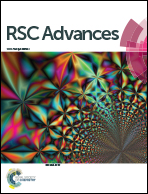Quantitative fluorescence assays using a self-powered paper-based microfluidic device and a camera-equipped cellular phone†
Abstract
Fluorescence assays often require specialized equipment and, therefore, are not easily implemented in resource-limited environments. Herein we describe a point-of-care assay strategy in which fluorescence in the visible region is used as a readout, while a camera-equipped cellular phone is used to capture the fluorescent response and quantify the assay. The fluorescence assay is made possible using a paper-based microfluidic device that contains an internal fluidic battery, a surface-mount LED, a 2 mm section of a clear straw as a cuvette, and an appropriately designed small molecule reagent that transforms from weakly fluorescent to highly fluorescent when exposed to a specific enzyme biomarker. The resulting visible fluorescence is digitized by photographing the assay region using a camera-equipped cellular phone. The digital images are then quantified using image processing software to provide sensitive as well as quantitative results. In a model 30 min assay, the enzyme β-D-galactosidase was measured quantitatively down to 700 pM levels. This communication describes the design of these types of assays in paper-based microfluidic devices and characterizes the key parameters that affect the sensitivity and reproducibility of the technique.


 Please wait while we load your content...
Please wait while we load your content...